PSRAM – Pseudostatic RAM
HYPERRAM™ - Low pin-count, high bandwidth pSRAM memory in a small footprint
Infineon offers a comprehensive portfolio of HYPERRAM™/Octal xSPI RAM memories with densities ranging from 64 Mb to 512 Mb. With its unique blend of high bandwidth and low pin-count, HYPERRAM™ is ideal for a wide range of industrial and automotive applications that require additional RAM for data-intensive operations. These energy efficient pSRAMs are also the ideal expansion memory choice for battery-operated consumer and wearable devices.
- Small-form-factor of 6 x 8 mm
- Lower pin-count with xSPI/HYPERBUS™
- Energy-efficient with hybrid sleep
- High throughput up to 800 Mbps
- HYPERFLASH™ plus HYPERRAM™ as MCP
- Scalable densities up to 512 Mb
- AEC-Q100 devices with up to 125°C
- Wide eco-system support
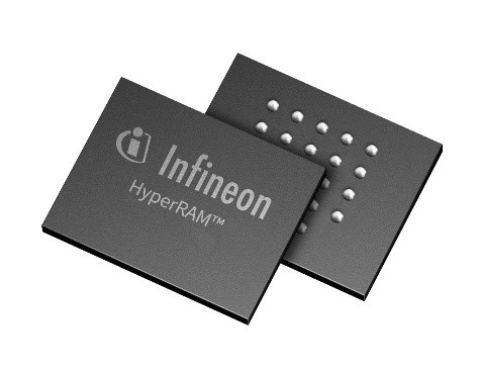
HYPERRAM™ - Pseudostatic RAM (pSRAM) technology
HYPERRAM™ is a high-speed CMOS, self-refresh DRAM, with a HYPERBUS™ interface. Its memory array is internally structured like DRAM, but externally acts like SRAM.
The DRAM array requires a periodic refresh to maintain data integrity. HYPERRAM™ internally manages the refresh operations on the DRAM array when the memory is not being actively read or written by a host. Since the host is not required to manage any refresh operations, the DRAM array appears to the host as static cells that retain data without refresh. Hence, HYPERRAM™ is described as pseudostatic RAM (pSRAM).
These low-power, high-performance, and low pin-count pSRAMs are suitable for applications requiring additional RAM for buffering data, audio, images, video, or as a scratchpad for math and data-intensive operations.
- Density: 64 Mb, 128 Mb, 256 Mb, 512 Mb
- Interface: HYPERBUS™ (x8), Octal xSPI (x8), and HYPERBUS™ Extended I/O (x16)
- Key features:
- Small-form-factor - FBGA package ensures a small PCB footprint
- Low pin-count - simplifies design and reduces system cost
- Low power - hybrid sleep mode and partial-array-refresh for energy efficiency
- High throughput - high read/write bandwidth to maximize system performance
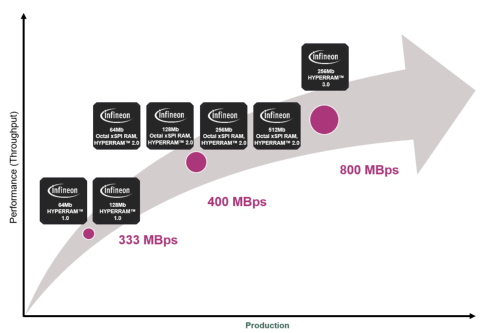
Infineon's HYPERRAM™ family
HYPERRAM™ 2.0 is the second generation of low pin-count pSRAM from Infineon that supports throughputs of up to 400 MBps. HYPERRAM™ 2.0 products are available from 64 Mb up to 512 Mb. HYPERRAM™ 2.0 devices are available with Octal xSPI and HYPERBUS™ interface.
Our third-generation pSRAM products - HYPERRAM™ 3.0, doubles the throughput to 800 MBps using a new, 16-bit, extended version of the HYPERBUS™ interface. 256 Mb HYPERRAM™ 3.0 products are now available in production.
These pSRAM products are industrial/automotive-qualified and support JEDEC-compliant Octal xSPI and HYPERBUS™ interface.

HYPERBUS™/xSPI x8 DDR interface with low signal count
HYPERBUS™ is a low signal count DDR interface that achieves high-speed read and write throughput. It utilizes a high-speed 8-bit DDR interface for both address and data along with a differential clock, a read/write latch signal, and a chip select.
HYPERBUS™ can also support external NOR flash and RAM on the same bus and works with any microcontroller with a HYPERBUS™-compatible peripheral interface. This requires only 13 pins for data transactions (12-pin HYPERBUS™ + 1 additional chip select for the second memory device).
HYPERRAM™ vs. competing expansion memory solutions
HYPERRAM™ products achieve a far higher throughput per pin compared to competing technologies such as traditional ADMUX pSRAMs and SDR DRAMs which are based on a parallel interface. The built-in self-refresh circuitry and low-power features such as partial-array-refresh and hybrid-sleep enable lower power consumption making HYPERRAM™ apt for power-constrained applications such as wearables and IoT devices.
|
HYPERRAM™ devices are used in demanding applications
HYPERRAM™’s high throughput, low pin-count, smaller footprint, and energy efficiency makes it an ideal expansion memory choice for a variety of automotive, industrial, consumer, and communication applications.
- Automotive instrument clusters
- HYPERRAM™ memories provide density-scalability to meet the requirements of different instrument cluster systems. These memory devices provide an ideal solution for real-time graphics and high-speed access. The low-pin count interface also reduces design complexity and PCB size to save on design costs.
- Industrial machine vision cameras
- FPGA used in Industrial applications have limited internal RAM resources and often require low pin-count external memory for image processing. HYPERRAM™ with its lower pin-count and higher density makes it an ideal expansion memory solution. Read more about automotive applications here
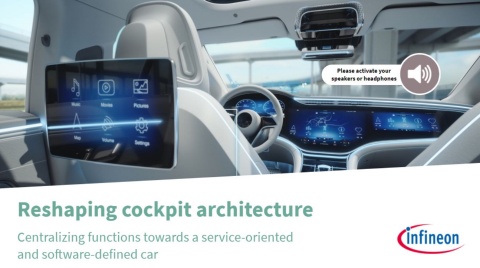
- Understand the evolution of the cockpit architecture
- Recognize the importance of the central modules like head unit and cockpit domain controllers and get to know Infineon solutions and their components
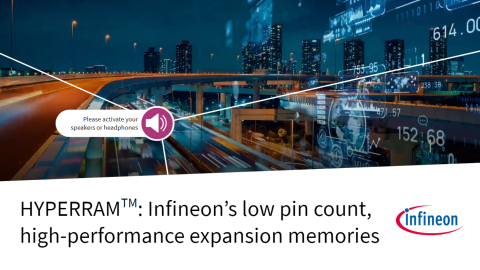
- Understand the need for an expansion memory and recognize the key attributes designers look for
- Describe the challenges with existing expansion memory options
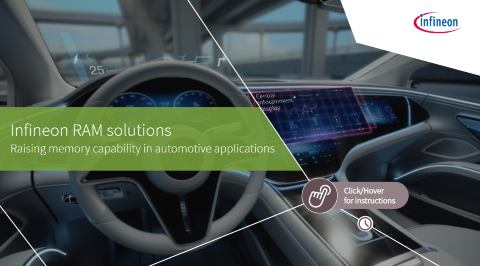
- Understand the key features of RAM offerings, and be aware of the memory solutions applications in automotive
- Know the RAM product portfolio, understand the different types of memories, key applications and use cases

- Know what Industry 4.0 is and the main challenges of high tech challenges in realizing its vision
- Understand the key features of RAM offerings and be aware of memory solutions use cases for the industrial market



